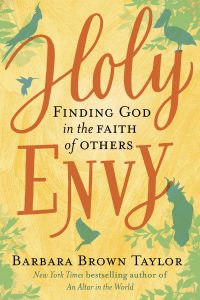During the first quarter of the year, I was fortunate to spend time reading a considerable number of excellent books published in 2019. The list below captures the best volumes I’ve read over the last few weeks.
- (5+) Holy Envy:
 Finding God in the Faith of Others by Barbara Brown Taylor (HarperOne, 2019)
Finding God in the Faith of Others by Barbara Brown Taylor (HarperOne, 2019) - (4.5) The Good Immigrant: 26 Writers Reflect on America edited by Nikesh Shukla and Chimene Suleyman (Little, Brown, and Company, 2019)
- (4.5) The Right It: Why So Many Ideas Fail and How to Make Sure Yours Succeed by Alberto Savoia (HarperOne, 2019)
- (4.0) Family Systems and Congregational Life: A Map for Ministry by R. Robert Creech (Baker Academic, 2019)
- (4.0) The Art of Dying Well: A Practical Guide to a Good End of Life by Katy Butler (Scribner, 2019)
- (4.0) Honoring the Body: Meditations on a Christian Practice (The Practices of Faith) by Stephanie Paulsell (Fortress Press, 2019)
- (4.0) Growing With: Every Parent’s Guide to Helping Teenagers and Young Adults Thrive in Their Faith, Family, and Future by Kara Powell and Steve Argue (Baker Books, 2019)
- (3.5) Don’t Just Send a Resume: How to Find the Right Job in a Local Church by Benjamin Vrbicek (Fan and Flame Press, 2019)
So What?
While I’ve long enjoyed the writing of Barbara Brown Taylor none of her previous books impacted me or resonated with me nearly as much as Holy Envy. The significance of this remark is better understood when one recognizes that I named Learning to Walk in the Dark one of my top books of 2014.
Barbara Brown Taylor is an Episcopal priest who transitioned from parish ministry to teaching at Piedmont College in the late 1990s. During her more than 20 year tenure at that institution, she taught Religion 101 more than any other course. This introductory course in world religions was a survey style course that covered five of the world’s great religions over a fifteen week semester. Most of her students were Christians who entered her classroom with limited religious literacy.
Holy Envy is the title of this book, and a wonderful way for anyone to approach religions other than one’s own. The term, which she credits to Krister Stendahl, was the final of Stendahl’s three recommendations for increased religious understanding:
1. When trying to understand another religion, you should ask the adherents of that religion and not its enemies.
2. Don’t compare your best to their worst.
3. Leave room for holy envy (p.64).
The book’s subtitle – Finding God in the Faith of Others – is equally important as it describes the author’s two decade long journey as a professor committed to improving Religion 101 each time she taught it by learning from experiences of those who practiced religions other than Christianity. This journey included the traditional efforts of reading and other scholarly pursuits, but was most transformative in experiential endeavors – especially the many field trips she led that offered her students real world experiences of other religions.
Reading this book will result in increased religious literacy. More importantly, those who engage these pages with an open mind will see their own religion more clearly and be better prepared to display holy envy in interactions with those who practice other religions.
Disclaimer: Parts of my own story parallel Barbara Brown Taylor’s experiences. After several years of parish ministry in a variety of Mainline Protestant denominations I spent eight years teaching at a university, primarily a survey of world religions course to undergraduate students who were Christians or religious nones.